The idea of enabling positive social change is integral to
student work at Walden University. Part of Walden’s mission is to help its students
“enact positive social change,” and Walden’s
vision is for students to use their education for “the greater global
good.” The Writing Center has also
incorporated social change into our mission: “Our staff of dedicated professionals
supports students in building and applying their writing skills as scholars,
practitioners, and agents of positive social change.” Walden’s Global
Days of Service this week prompted me to think more about social change and
how writing can contribute to Walden and the Writing Center’s missions of
social change.
One important component of social change is speaking up.
When we work for social change, we speak up for what we believe is right. This
means making our own voice heard, but it can also include helping others’ voices to be heard. Knowing how
to speak up can be a challenge, particularly when we are working to address
problems and issues about which we are passionate.
Louise Dunlap’s book Undoing the Silence: Six Tools for Social
Change Writing addresses this
idea of speaking up, highlighting the ability we all have to enact social
change through writing. First, however, Dunlap believes that we must address
the ways we are silenced, interrupting
our ability to speak, before we can effectively promote social change. This
silencing can manifest itself in ways that we often don’t recognize:
 |
| Louise Dunlap. Photo (c) http://www.undoingsilence.org |
“I…picture the silencing of our voices as a huge stifling knot, layered together with tangled strands from many aspects of our culture. In this knot, impulses we regard as deeply personal are interwoven and reinforced by the institutions around us” (p. 16).
What Dunlap suggests, however, is that this silence can be
broken through writing. Writing, she says, can give everyone a voice and a way
to be heard.
Undoing the silence is the goal of Dunlap’s book, and throughout
each chapter she explains different tools to achieve this goal. Dunlap explains
tools and techniques we can use at the very beginning of the writing process,
like freewriting and brainstorming, but also tools that can help you consider
the audience for your writing and revising for that audience.
 |
| Photo (c) http://www.newvillagepress.net |
Because of her perspective, I recommend Dunlap’s book to
anyone who aims to have a social change focus in their writing (hint: all
Walden students). If you’re a doctoral student, Undoing the Silence—particularly Chapter
6, “The AUDIENCE Tool”—may help you articulate your social change statement in
your study. If you’re a master’s student, Chapter 5, “The THINKING Tool,” can
help you develop and deepen your ideas. If you’re an undergraduate student, pay
particular attention to Chapter 3, “The FREEWRITING Tool,” to help you generate
ideas.
But, no matter what type of student you are or what kind of
writer, I encourage you to read Chapter 2, “Understanding the Silence.” In this
chapter, Dunlap expands on ways she sees writers being silenced. Understanding
the silence, Dunlap explains, is the first step to breaking the silence, enabling you to better articulate and enacte the social change you want to achieve.
How have you seen writing help you articulate and achieve
social change? How have you broken through the silence to speak for social
change? Let us know in the comments below!
Other posts you might like:How to Write for Positive Social Change
Global Days of Service Week is Coming! #IAmSocialChange
Writing for Change on Earth Day (and Every Day)

Writing Instructor and Coordinator of Webinar Writing Instruction Beth Oyler writes about literature in her spare time and enjoys contemplating the possibilities writing creates.


No comments:
Post a Comment